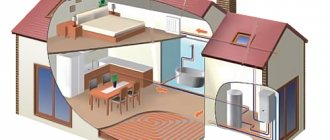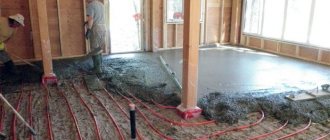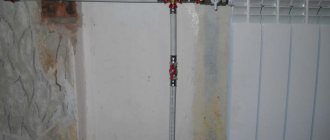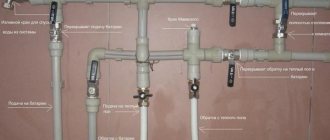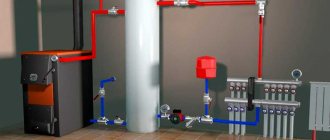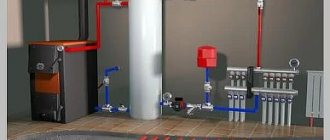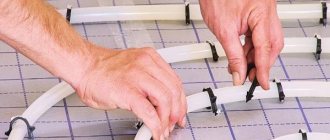A single-circuit or double-circuit gas boiler is equipment that makes our life in a house or apartment more comfortable. Manufacturers now produce a huge range of gas appliances, differing in power, functionality, and installation method. However, even the most expensive and reliable models can fail. Agree, it’s not very pleasant to be left on a winter evening without heat and hot water.
Having analyzed the possible causes of breakdowns of gas equipment, we came to the conclusion that most often malfunctions occur due to the fact that the pressure in the expansion tank of a gas boiler or water heater is incorrectly adjusted. In this article we will figure out why an expansion tank is needed, how to pump air into it yourself and set the optimal pressure.
Why is an expansion tank needed?
During the heating process, water tends to expand - as the temperature rises, the volume of the liquid increases. Pressure begins to increase in the heating system circuit, which can have a destructive effect on gas equipment and the integrity of the pipes.
The expansion tank (expanzomat) serves as an additional reservoir into which excess water formed as a result of heating is pressed out. When the liquid cools and the pressure stabilizes, it returns through the pipes back into the system.
The expansion tank acts as a protective buffer; it dampens water hammer, which constantly forms in the heating system due to frequent turning on and off of the pump, and also eliminates the possibility of air locks.
To reduce the likelihood of air locks and prevent damage to the gas boiler due to water hammer, the expansion tank should be mounted in front of the heat generator, on the return line
There are two different types of damper tanks: open and closed types. They differ not only in design, but also in the method and location of installation. Let's look at the features of each of these types in more detail.
Open expansion tank
An open type tank is mounted at the top point of the heating system. The containers are made of steel. Most often they have a rectangular or cylindrical shape.
Typically, such expansion tanks are installed in the attic or attic. Installation under the roof is possible. It is imperative to pay attention to the thermal insulation of the structure
The structure of the open-type tank has several outlets: for water inlet, cooled liquid outlet, control pipe inlet, and also an outlet pipe for coolant discharge into the sewer. We wrote more about the structure and types of an open tank in our other article.
Open tank functions:
- controls the coolant level in the heating circuit;
- if the temperature in the system has decreased, it compensates for the volume of coolant;
- when the pressure in the system changes, the tank acts as a buffer zone;
- removes excess coolant from the system into the sewer system;
- removes air from the circuit.
Despite the functionality of open expansion tanks, they are practically not used anymore. Since they have many disadvantages, for example, the large size of the container, the tendency to corrosion. They are installed in heating systems that operate only with natural water circulation.
Closed expansion chamber
In closed-circuit heating systems, a membrane-type expansion tank is usually installed; it is optimally suited for any type of gas boiler and has many advantages.
An expansomat is a hermetic container, which is divided in the middle by an elastic membrane. The first half will contain excess water, and the second half will contain regular air or nitrogen.
Closed expansion tanks for heating are usually painted red. There is a membrane inside the tank; it is made of rubber. A necessary element to maintain pressure in the expansion tank
Compensation tanks with a membrane can be produced in the form of a hemisphere or in the form of a cylinder. Which is quite suitable for use in a heating system with a gas boiler. We recommend that you familiarize yourself in more detail with the installation features of closed tanks.
Advantages of membrane types of tanks:
- ease of self-installation;
- corrosion resistance;
- work without regular addition of coolant;
- lack of contact of water with air;
- performance under high load conditions;
- tightness.
Gas attachments are usually equipped with an expansion tank. But the additional tank is not always configured correctly from the factory and can immediately start heating.
Air pressure in the expansion tank
The air or nitrogen pressure in the expansion tank will not be the same for different gas boilers; it all depends on the type of equipment and design features. The standards are indicated by the manufacturer in the product passport.
Typically, the pressure in a new damper tank is 1.5 atm. But this setting may not be suitable for a specific heating system. Factory settings are easy to reset. For these purposes, there is a special fitting in the expansion tank housing (for some manufacturers this is a spool valve for pumping), through which the air pressure is adjusted.
The nipple is located on the side of the air chamber of the cylinder. With its help you can release excess pressure or, conversely, pump up the tank
For the normal functioning of a gas boiler, it is necessary that the pressure in the membrane tank be 0.2 atm less than in the system itself. Otherwise, the heated water that has increased in volume will not be able to enter the container.
In small houses and apartments for closed heating systems, the pressure in the expansion tank is usually acceptable in the range of 0.8-1.0 bar (atm). But not less than 0.7 bar, since many gas boilers have protection and the device simply will not turn on.
The tank pressure level should be checked annually. If pressure surges are noticed in the heating system, it means that air has come out of the damper tank and needs to be pumped up.
Installation nuances
Installation begins with choosing a location for the electric boiler room; when installing powerful units over 6 kW, a separate room without access by unauthorized persons and children is recommended. New heating elements of an industrial heating boiler can be installed in the kitchen. The EC is positioned so that there is free space around it for maintenance and repair. Minimum clearances:
- to the top floor of the room - 0.80 m;
- to the “0” mark in the case of a mounted type - at least 0.50 m;
- to the walls - 0.05 m;
- to pipes - more than 0.50 m;
- in front of the boiler front - more than 0.70 m.
The level of the housing is important - it must be strictly horizontal.
The installation of the boiler depends on the type of heating system - with natural circulation, the electric boiler is located at the lowest point, with forced circulation - in any convenient place. It is possible to install not one unit, but several; in this case, they are connected in parallel so that they work with the same load.
Installation algorithm:
- For a wall-mounted structure, first install the brackets that are supplied with the unit.
- After attaching them to the wall with dowels or anchors, the housing is hung.
- The floor-standing unit is installed on a flat dielectric stand.
- They tie the heating and hot water circuits.
- Install shut-off and control valves on the inlet and outlet pipes.
- Install the sump sensors, pressure gauges and thermometers according to the working diagram.
- Connect the unit to the electrical network. A corrugated flexible pipeline can be used as a cable channel.
- If power surges in the network are frequent, then the connection must be made through a stabilizer.
- Electrical protection is installed, the fuse power is selected higher than the highest current load of the boiler in operating condition, grounding is required when connecting. Ground a 3- or 5-wire cable.
- The neutral working wire N is connected to the neutral bus of the panel.
- The grounding PE wire is connected to its “Earth” bus.
- For the power line, use the VVG brand of cable with the number of cores 3 or 5, with sections corresponding to the power of the EC, usually the size is indicated in the product passport.
- The double-circuit boiler is connected through a three-way electric valve. Based on a signal from the thermostat, it directs the coolant flow to heat the DHW or heating circuit.
- After completing the installation work, the boiler is inspected and made sure that it is installed strictly horizontally and all communications are connected to it.
- The boiler is filled with water and a pressure test is performed under tap water to determine leaks in the connections and the serviceability of the shut-off and control valves.
- Check the operation of the electrical equipment of the boiler and the circulation pump built into the boiler.
- Test the performance of sensors and security automation.
Electric boilers with a pump are the most advanced heating method with the possibility of modern heating control from 0 to 100%. Using the Smart Home system, control can be performed online, outside the walls of the house. And although the pump itself consumes additional electricity for its operation, these costs are quickly recouped in terms of comfort, autonomy and safety of services. The most important thing is that this scheme has a great future, given that any secondary energy resources from green energy can be easily integrated into it, which is why this type of heat supply is gaining popularity all over the world.
How to set the optimal pressure?
The heating system has pressure gauges that control the pressure in the circuit. On the expansion tank itself there is no fitting for installing a measuring device. But there is a nipple or spool for releasing and pumping air or gas. The nipple is the same as on car wheels. Therefore, you can check the pressure level and adjust it using a conventional car pump with a pressure gauge.
Even a simple automobile hand pump with a pressure gauge or an automatic compressor will be suitable for pumping air into the expansion tank.
Before releasing excess pressure or pumping air into the expansion tank of a domestic gas boiler, it is necessary to prepare the system. The car pressure gauge shows the value in MPa; the data obtained must be converted into atmospheres or bars: 1 Bar (1 atm) = 0.1 MPa.
Pressure measurement algorithm:
- Turn off the gas boiler. Wait until water stops circulating through the system.
- In the area with the hydraulic tank, close all shut-off valves and drain the coolant through the drain fitting. For boilers with a built-in tank, the return flow is shut off, as well as the water supply.
- Connect the pump to the tank nipple.
- Pump up the air to 1.5 atm. Wait a little for the remaining water to pour out, then let the air in again.
- Close the valves of the shut-off valves and use a compressor to pump up the pressure to the parameters specified in the passport or to the level - pressure in the system minus 0.2 atm. If the tank is pumped, excess air is released.
- Remove the pump from the nipple, screw on the cap and close the drain fitting. Fill the system with water.
You can check the correct air pressure adjustment when the boiler reaches operating parameters.
If the tank is inflated correctly, then the needle on the pressure gauge of the device during measurement will show a smooth increase in pressure without any jumps or jerks
If the air pressure in the expansion tank is incorrectly adjusted, the entire heating system may malfunction. If the expansion tank is over-inflated, the compensating properties will not work. Because the air will push excess heated water out of the tank, increasing the pressure in the pipes of the heating system.
And with underestimated pressure readings of the compensating tank, water will simply push through the membrane and fill the entire tank. As a result, when the coolant temperature rises, the safety valve will operate.
Sometimes in double-circuit gas boilers, fuses work even if the pressure of the built-in expansion tank is correctly adjusted. This indicates that the tank volume is too small for such a heating system. In this situation, it is recommended to install an additional hydraulic tank.
How to calculate the power of an electric boiler
When choosing a suitable option for an electric boiler with a pump and expansion tank, first of all, we focus on its power. It must be such that all heat losses from the heating system are fully compensated. In addition, the boiler is responsible for an uninterrupted supply of hot water.
Before choosing a suitable heating device model, it is necessary to make a detailed thermal calculation. It takes into account not only the total area of the heated premises, but also the condition of the walls, floors and ceilings, the quality of insulation, and the presence of modern windows and doors. To calculate a boiler for heating a private cottage, it is allowed to use a simplified scheme. Using the instructions below, you can independently determine the necessary device parameters.
To do this you will need the following formula:
W = S x Wsp /10m2, where:
- W – required heating power (kW).
- S – total area of all heated premises (m2).
- Wsp – specific power per 10 m2.
Wsp has different values in different regions. In areas with a harsh climate, this parameter ranges from 1.2-2. In the central zone of Russia, Wud corresponds to 1; in the southern regions values of 0.7 – 0.8 are used.
Purpose of an additional tank of a double-circuit boiler
As a rule, built-in compensation tanks in gas boilers have a volume of about 6-8 liters. They are designed to compensate for the expansion of 120 liters of coolant circulating in the heating system. Under normal operating conditions, such an expansion tank is enough for a small apartment or house.
When installing radiators of non-standard shape and size, the heating system must be equipped with an additional expansion tank. Because these batteries hold more water
If the heating area is large, heated floors are installed or there are many radiators in the rooms, the volume of the standard built-in tank will be small, since more water is used.
When heated, excess coolant completely fills the tank. And since there is no free space left in the tank, the water pressure increases in the heating system itself and an emergency release occurs by the safety valve. After this, it is unlikely that the gas boiler will be able to start working automatically.
To avoid such negative consequences, an additional expansion tank with a membrane is installed in the heating system in a design for a double-circuit gas boiler. When the standard tank is completely filled, the water goes into the reserve hydraulic tank. After cooling, the liquid returns to the radiators.
Is it necessary to install an additional pump and expansion tank?
Is it necessary to install an additional pump and expansion tank?
Post by Demyan » 08 Sep 2021, 14:05
In cases where gas heating cannot be used due to the lack of supply lines, electric boilers with a pump are a good option. Thanks to a number of positive characteristics, these devices are gaining mass popularity among consumers.
Calculation of expansion tank volume
It is not difficult to ensure stable operation of the heating system; the main thing is to correctly select the volume of the compensation tank. The volume of the expansion tank should be calculated taking into account the most intensive operating mode of the gas boiler. When heating is first started, the air temperature is not yet very low, so the equipment will operate at an average load. With the arrival of frost, the water warms up more and its quantity increases, requiring more additional space.
It is recommended to select a tank with a capacity of at least 10-12% of the total amount of liquid in the heating system. Otherwise, the tank may not be able to cope with the load.
You can independently calculate the exact capacity of the expansion tank. To do this, first determine the amount of coolant in the entire heating system.
Methods for calculating the volume of water in the heating system:
- Completely drain the coolant from the pipes into buckets or other containers so that the displacement can be calculated.
- Pour water into the pipes through the water meter.
- The volumes are summed up: the capacity of the boiler, the amount of liquid in the radiators and pipes.
- Calculation based on boiler power - the power of the installed boiler is multiplied by 15. That is, for a 25 kW boiler you will need 375 liters of water (25 * 15).
After the amount of coolant has been calculated (example: 25 kW * 15 = 375 liters of water), the volume of the expansion tank is calculated.
There are many methods, but not all of them are accurate and the amount of water that fits into the heating system can be much greater. Therefore, the volume of the expansion tank is always selected with a small margin
The calculation methods are quite complex. For one-story houses, use the following formula:
Expansion tank volume = (V*E)/D,
Where
- D – tank efficiency indicator;
- E – liquid expansion coefficient (for water – 0.0359);
- V is the amount of water in the system.
The tank efficiency indicator is obtained using the formula:
D = (Pmax—Ps)/(Pmax +1),
Where
- Ps =0.5 bar is an indicator of the charging pressure of the expansion tank;
- Pmax – maximum pressure of the heating system, on average 2.5 bar.
- D = (2,5-0,5)/(2,5 +1)=0,57.
For a system with a boiler power of 25 kW, an expansion tank with a volume of: (375*0.0359)/0.57=23.61 l will be required.
And although a double-circuit gas boiler already has a built-in 6-8 liter tank, looking at the calculation results, we understand that stable operation of the heating system will not be possible without installing an additional expansion tank.
How to choose a suitable model with an expansion tank
When choosing an electric heating boiler with a pump for your home, it is recommended to pay attention to the following criteria:
- Power . Affects the performance of heating elements in the heat exchanger (it is indicated in kW). The boiler power is determined by the heating elements. In most cases, models on the modern market have a power from 2-3 to 60-70 kW per heater. Appliances with low power are usually used to heat small private houses and cottages. Boilers with ratings of more than 50 kW are used in the industrial sector.
- Capacity of the thermal accumulator . Thanks to this tank, a significant increase in the efficiency of the boiler is achieved, so it must be installed. The volume of the heat accumulator directly affects the efficiency of coolant distribution in the pipeline. As experts advise, when choosing a tank, you need to focus on the ratio of 20 l/1 kW of boiler power.
- Voltage . In houses with single-phase 220 V networks, boilers up to 12 kW can be used. If it is necessary to install a more powerful device, then in this case you will have to install a three-phase network (380 V).
- Cross-section of switching wires . As the power of heating equipment increases, thicker cabling must be used to supply electricity to the system. Devices with a power of up to 4 kW can be equipped with cables with a cross-section of 4 mm 2, and boilers of 12 kW single-phase type are connected with cables of 16 mm 2.
In addition to heating elements, electric boilers also include electrode and induction boilers. In the latter case, we are talking about a small dielectric tube and a ferromagnetic rod. The coolant moves inside the tube, heating up due to the passing electric current. The advantage of these models is durability, compactness and efficiency (the “soft start” function allows you to save almost 50% of electricity). The disadvantage of induction devices is the presence of a complex control unit.
As for electrode units, they are also called “direct action” devices (due to the absence of a heating element). Heating of the coolant occurs while an alternating electric current with a frequency of 50 Hz moves through it. Such equipment is safe, as it is equipped with an automatic security system. The disadvantages of electrode boilers include the need for enhanced preparation of the coolant, which must have the required resistance. Regular replacement of the electrodes will also be required due to their gradual dissolution.
